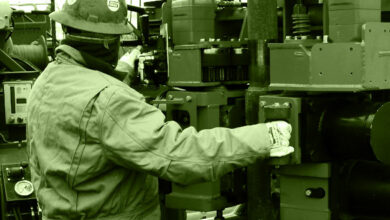Technical Session 11 – Early Detection & Well Control
Editor’s note: These abstracts have been edited for space and clarity. This program is current as of 15 January 2013. Additions, withdrawals and other changes to the conference program after this date may not be reflected. Click here for the most updated program.
TECHNICAL SESSION 11: EARLY DETECTION AND WELL CONTROL
SPE/IADC 163499
Subsea Cap and Contain Method for a Deepwater Tension Leg Platform, J.A. Henley, T. Webb, Shell Exploration and Production; J. Soliah, Delmar
This paper will focus on four key aspects of Shell’s TLP containment plan. The combination of two existing proven techniques, the heave compensated landing system and the suction pile based pipeline initiation methods, have been adapted as the enabling technologies to meet these four key aspects. Additional methods and constraints have been identified for development and inclusion in the base response plan as needed.
SPE/IADC 163474
Automated Alarms for Smart Flowback Fingerprinting and Early Kick Detection, T.H. Ali, S. Haberer, I.P. Says, C.C. Ubaru, M.L. Laing, Baker Hughes; O. Helgesen, M. Liang, B. Bjelland, Statoil USA
This publication focuses on the development and deployment of an automated flowback monitoring technology. The new solution aids drillers and drilling engineers by generating intelligent alarms relevant to current well conditions for early kick and loss detection, which can result in detecting kicks up to one connection earlier than the existing manual method. This paper demonstrates the benefits of the smart flowback fingerprinting over existing practices and how it can significantly reduce safety risks and NPT.
SPE/IADC 163417
Detect Kicks Prompted by Losses and Direct Measurement Well Control Method through Networked Drill String with Along String Pressure Evaluation, D.M. Veeningen, National Oilwell Varco
This paper describes efficient detection of well control events, both in underbalanced and overbalanced conditions, which is especially relevant for deepwater operations as the reaction time is significantly less than with surface BOPs. A methodology is offered to detect the annulus fluid level in conditions of unknown hydrostatic column height and fluid density through the use of discrete annular pressure acquisition along a networked drill string. The downhole real-time pressure evaluation also provides for monitoring of the gas migration to manage annular filling, while losses continue to be experienced. Further, the direct measurement method is offered for well control based on constant bottomhole pressure through downhole pressure measurements independently from surface measurements.
SPE/IADC 163515
Advances in Real-Time Event Detection While Drilling, R. Wong, Q. Liu, M. Ringer, J. Dunlop, J.C. Luppens, C. Chapman, H. Yu, Schlumberger
New sensors and enhancements to the Bayesian inference techniques significantly improve event detection and its extension to more complex scenarios making them more suitable for application to automated systems.
Although applicable to a broader set of events, improvements to these previous event detection methods are described with a focus on a new drill string washout detection module. The new module combines a method of detection of on-bottom drilling with enhanced signal characterization of standpipe pressure and flow to create an algorithm that can effectively handle drilling with a motor.
SPE/IADC 163454
Calibrating Automated Event Detection Algorithms for Real-Time Wellbore Stability Applications, S. Wessling, A. Bartetzko, P. Tesch, T. Dahl, Baker Hughes
After an introduction into drilling automation and wellbore stability analysis, this paper presents different approaches for the automatic analysis and interpretation of formation evaluation logs for the detection of drilling events. These algorithms were extensively tested on more than 30 data sets. The approaches are beneficial to monitor the wellbore conditions and to deliver alarms about potential overpressure regions and breakouts on the formation wall. Observations obtained from testing are put into the context of developing an automated alarm and advice-generation system. Experience with alarm generation within other communities and its comparison to the oil and gas industry will be highlighted.
SPE/IADC 163445
Feasibility Study of Applying Intelligent Drill Pipe in Early Detection of Gas Influx during Conventional Drilling, A. Karimi Vajargah, S.Z. Miska, M. Yu, University of Tulsa; R. Majidi, BP America
This paper proposes a technique for early gas detection during conventional drilling by utilizing intelligent drill pipe. For this purpose, different involved flow regions in the annulus are identified and modeled based on the conservation equations. A numerical scheme and transient gas kick simulator are developed to solve the equations. Sensitivity analysis is conducted for various parameters such as influx sizes, mud flow rates and wellbore geometry.
E-POSTERS:

SPE/IADC 163442
Full-Scale Testing Shows Advantages of a Quantitative Approach to Interpreting Negative Pressure Tests, R. Rahmani, J.R. Smith, D.A. Bourgoyne, Louisiana State University
Negative pressure tests are an important step in proving well integrity for some well operations. Although the concept is straightforward, there are no standard procedures for conducting and interpreting negative tests. Recent industry experience has shown the potential for these tests to be misinterpreted with disastrous results. This paper describes proper quantitative interpretation of both successful and unsuccessful tests demonstrated on two full-scale test wells.
SPE/IADC 163545
Swab and Surge Effects Due to Heave of Vessel in Deepwater Wells: Model Development and Benchmarking, P.V. Suryanarayana, S. Chandrasekhar, W. Bacon, Blade Energy Partners; B. Toldo, Woodside Energy
In this paper, we present the development of a semi-analytical approach to model transient pressure problems. The transient pressure problem is solved using the method of characteristics. The method is extended to include power-law fluids. Arbitrary flow ports can be situated anywhere in the string, with either one or two-way flow. Both open- and closed-end pipes are considered, in addition to nozzles at the pipe end. Temperature and pressure effects on the compressibility and elasticity of the formation, are considered. The approach can accept any arbitrary forcing function at surface, either as a periodic wave or as a tabulated time function of displacements.
SPE/IADC 163550
Deepwater Well Control – An Important Way Forward, C.P. Leach, J.M. Mounteer, Argonauta Drilling Services LLC
Following Macondo (and other well control incidents), great strides have been made with respect to well control, and much discussion and reflection has taken place.
This paper looks at the processes that must be conducted and gives examples of these. In particular, this requires a deep understanding of the interactions of real reservoir fluids (gas, volatile oil) with typical drilling mud which will be oil based. Examples of what will be seen for these combinations are given along with the resultant detailed solutions/approaches/procedures.



